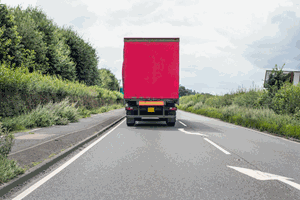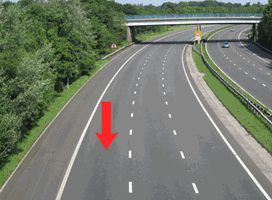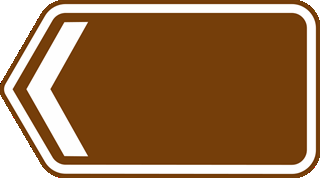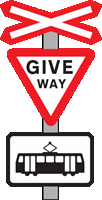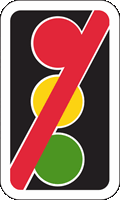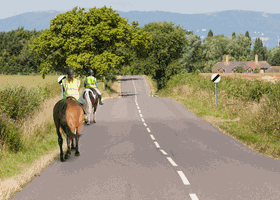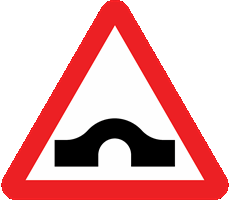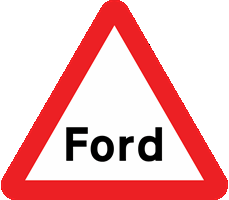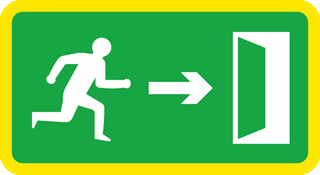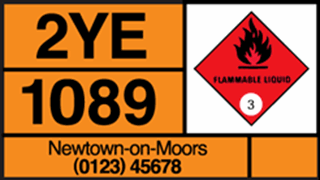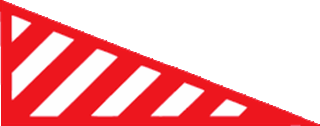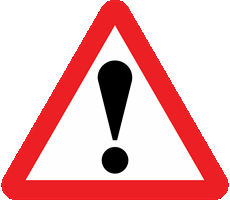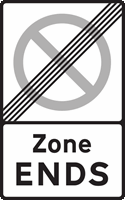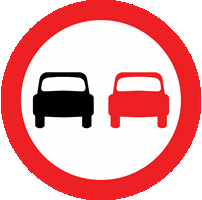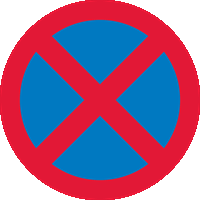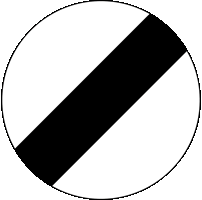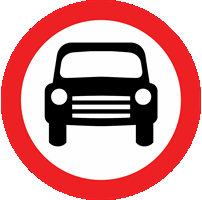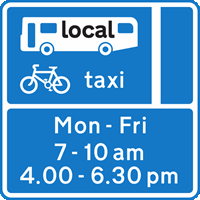You have 57 minutes to answer 50 multiple choice driving theory test questions. You need to answer at least 43 out of 50 questions correctly to pass. You can review your answer after each question or you can review all of your answers at the end of the test. Best of luck!
Test Quick View
Click on an answer to view the correct choice along with the explanation.
Correct Answer: D
Explanation: Staying back will increase your view of the road ahead. This will help you to see any hazards that might occur and allow you more time to react.
Explanation: Staying back will increase your view of the road ahead. This will help you to see any hazards that might occur and allow you more time to react.
پیچھے رہنے سے آپ کو آگے زیادہ سڑک دکھائی دے گی۔ یہ آپ کو کسی ممکنہ خطرے کو دیکھنے اور اس سے بچاو کے لئے مدد کرتا ہے
2. You're approaching a roundabout. There are horses just ahead of you. What should you do? Mark one answer
AB
C
D
Correct Answer: B
Explanation: Horse riders often keep to the outside of the roundabout even if they're turning right. Give them plenty of room and remember that they may have to cross lanes of traffic.
Explanation: Horse riders often keep to the outside of the roundabout even if they're turning right. Give them plenty of room and remember that they may have to cross lanes of traffic.
Correct Answer: A
Explanation: On a motorway, all traffic should use the left-hand lane unless overtaking. When overtaking a number of slower vehicles, move back to the left-hand lane when you're safely past. Check your mirrors frequently and don't stay in the middle or right-hand lane if the left-hand lane is free.
Explanation: On a motorway, all traffic should use the left-hand lane unless overtaking. When overtaking a number of slower vehicles, move back to the left-hand lane when you're safely past. Check your mirrors frequently and don't stay in the middle or right-hand lane if the left-hand lane is free.
4. You've had a breakdown on the hard shoulder of a motorway. When the problem has been fixed, how should you rejoin the main carriageway? Mark one answer
AB
C
D
Correct Answer: A
Explanation: Signal your intention and build up sufficient speed on the hard shoulder so that you can filter into a safe gap in the traffic. Don't push your way in, causing other traffic to alter speed or direction.
Explanation: Signal your intention and build up sufficient speed on the hard shoulder so that you can filter into a safe gap in the traffic. Don't push your way in, causing other traffic to alter speed or direction.
Correct Answer: D
Explanation: Signs with a brown background give directions to places of interest. They're often seen on a motorway, directing you along the easiest route to the attraction.
Explanation: Signs with a brown background give directions to places of interest. They're often seen on a motorway, directing you along the easiest route to the attraction.
Correct Answer: B
Explanation: Obey the 'give way' signs. Trams are unable to steer around you if you misjudge when it's safe to enter the junction.
Explanation: Obey the 'give way' signs. Trams are unable to steer around you if you misjudge when it's safe to enter the junction.
Correct Answer: C
Explanation: Some crossings have gates but no attendant or signals. You should stop, look both ways, listen and make sure that no train is approaching. If there's a telephone, contact the signal operator to make sure it's safe to cross.
Explanation: Some crossings have gates but no attendant or signals. You should stop, look both ways, listen and make sure that no train is approaching. If there's a telephone, contact the signal operator to make sure it's safe to cross.
Correct Answer: A
Explanation: When traffic lights are out of order, treat the junction as an unmarked crossroads. Be very careful and be prepared to stop; no-one has priority.
Explanation: When traffic lights are out of order, treat the junction as an unmarked crossroads. Be very careful and be prepared to stop; no-one has priority.
Correct Answer: C
Explanation: On a three-lane motorway, you should travel in the left-hand lane unless you're overtaking. This applies regardless of the speed at which you're travelling.
Explanation: On a three-lane motorway, you should travel in the left-hand lane unless you're overtaking. This applies regardless of the speed at which you're travelling.
Correct Answer: A
Explanation: When parking at night, park in the direction of the traffic. This will enable other road users to see the reflectors on the rear of your vehicle. Use your parking lights if the speed limit is over 30 mph.
Explanation: When parking at night, park in the direction of the traffic. This will enable other road users to see the reflectors on the rear of your vehicle. Use your parking lights if the speed limit is over 30 mph.
Correct Answer: D
Explanation: Be particularly careful when approaching horse riders - slow down and be prepared to stop. Always pass wide and slowly, and look out for signals given by the riders. Horses are unpredictable: always treat them as potential hazards and take great care when passing them.
Explanation: Be particularly careful when approaching horse riders - slow down and be prepared to stop. Always pass wide and slowly, and look out for signals given by the riders. Horses are unpredictable: always treat them as potential hazards and take great care when passing them.
Correct Answer: A
Explanation: You'll need to slow down. At hump bridges, your view ahead will be restricted and the road will often be narrow. If the bridge is very steep, sound your horn to warn others of your approach. Going over the bridge too fast is highly dangerous to other road users and could even cause your wheels to leave the road, with a resulting loss of control.
Explanation: You'll need to slow down. At hump bridges, your view ahead will be restricted and the road will often be narrow. If the bridge is very steep, sound your horn to warn others of your approach. Going over the bridge too fast is highly dangerous to other road users and could even cause your wheels to leave the road, with a resulting loss of control.
Correct Answer: D
Explanation: When a smart motorway is operating, you must follow the mandatory signs on the gantries above each lane, including the hard shoulder. Variable speed limits help keep the traffic moving and also help to prevent bunching.
Explanation: When a smart motorway is operating, you must follow the mandatory signs on the gantries above each lane, including the hard shoulder. Variable speed limits help keep the traffic moving and also help to prevent bunching.
14. You shouldn't normally travel on the hard shoulder of a motorway. When can you use it? Mark one answer
AB
C
D
Correct Answer: A
Explanation: Normally, you should only use the hard shoulder for emergencies and breakdowns, and at roadworks when signs direct you to do so. Smart motorways use active traffic management to ease congestion. In these areas, the hard shoulder may be used as a running lane when speed-limit signs are shown directly above.
Explanation: Normally, you should only use the hard shoulder for emergencies and breakdowns, and at roadworks when signs direct you to do so. Smart motorways use active traffic management to ease congestion. In these areas, the hard shoulder may be used as a running lane when speed-limit signs are shown directly above.
Correct Answer: D
Explanation: A ford is a crossing over a stream that's shallow enough to drive or ride through. After you've gone through a ford or deep puddle, your brakes will be wet and they won't work as well as usual. To dry them out, apply a light brake pressure while moving slowly. Don't travel at normal speeds until you're sure your brakes are working properly again.
Explanation: A ford is a crossing over a stream that's shallow enough to drive or ride through. After you've gone through a ford or deep puddle, your brakes will be wet and they won't work as well as usual. To dry them out, apply a light brake pressure while moving slowly. Don't travel at normal speeds until you're sure your brakes are working properly again.
16. What's the maximum speed of powered wheelchairs or scooters used by disabled people? Mark one answer
AB
C
D
Correct Answer: D
Explanation: Some powered wheelchairs and mobility scooters are designed for use on the pavement only and cannot exceed 4 mph (6 km/h). Others can go on the road as well, and this category cannot exceed 8 mph (12 km/h). Take great care around these vehicles. They're extremely vulnerable because of their low speed and small size.
Explanation: Some powered wheelchairs and mobility scooters are designed for use on the pavement only and cannot exceed 4 mph (6 km/h). Others can go on the road as well, and this category cannot exceed 8 mph (12 km/h). Take great care around these vehicles. They're extremely vulnerable because of their low speed and small size.
Correct Answer: C
Explanation: If you have to leave your vehicle and get out of a tunnel by an emergency exit, do so as quickly as you can. Follow the signs directing you to the nearest exit point. If there are several people using the exit, don't panic but try to leave in a calm and orderly manner.
Explanation: If you have to leave your vehicle and get out of a tunnel by an emergency exit, do so as quickly as you can. Follow the signs directing you to the nearest exit point. If there are several people using the exit, don't panic but try to leave in a calm and orderly manner.
Correct Answer: C
Explanation: You shouldn't normally stop on a motorway, but there may be occasions when you need to do so. If you're unfortunate enough to break down, make every effort to pull up on the hard shoulder.
Explanation: You shouldn't normally stop on a motorway, but there may be occasions when you need to do so. If you're unfortunate enough to break down, make every effort to pull up on the hard shoulder.
19. At an incident, a casualty is unconscious. You need to check whether they're breathing. How long should you allow for this check? Mark one answer
AB
C
D
Correct Answer: B
Explanation: Once the casualty's airway is open, listen and feel for breath. Do this by placing your cheek over their mouth and nose, and look to see if their chest rises. This should be done for up to 10 seconds. If you cannot detect any breathing, you should begin compressions.
Explanation: Once the casualty's airway is open, listen and feel for breath. Do this by placing your cheek over their mouth and nose, and look to see if their chest rises. This should be done for up to 10 seconds. If you cannot detect any breathing, you should begin compressions.
20. A tanker is involved in a collision. Which sign shows that it's carrying dangerous goods? Mark one answer
AB
C
D
Correct Answer: B
Explanation: There will be an orange label on the side and rear of the tanker. Look at this carefully and report what it says when you phone the emergency services. Details of hazard warning plates are given in The Highway Code.
Explanation: There will be an orange label on the side and rear of the tanker. Look at this carefully and report what it says when you phone the emergency services. Details of hazard warning plates are given in The Highway Code.
Correct Answer: B
Explanation: If you're travelling on an icy road, extra caution will be required to avoid loss of control. Keeping your speed down and using the highest gear possible will reduce the risk of the tyres losing their grip on this slippery surface.
Explanation: If you're travelling on an icy road, extra caution will be required to avoid loss of control. Keeping your speed down and using the highest gear possible will reduce the risk of the tyres losing their grip on this slippery surface.
22. You're about to reverse into a side road. A pedestrian is waiting to cross behind you. What should you do? Mark one answer
AB
C
D
Correct Answer: A
Explanation: If you need to reverse into a side road, try to find a place that's free from traffic and pedestrians. Look all around before and during the manoeuvre. Stop and give way to any pedestrians who want to cross behind you. Avoid waving them across, sounding the horn, flashing your lights or giving any signals that could mislead them and create a dangerous situation.
Explanation: If you need to reverse into a side road, try to find a place that's free from traffic and pedestrians. Look all around before and during the manoeuvre. Stop and give way to any pedestrians who want to cross behind you. Avoid waving them across, sounding the horn, flashing your lights or giving any signals that could mislead them and create a dangerous situation.
Correct Answer: C
Explanation: Don't attempt to overtake here, as there might be unseen hazards over the brow of the hill. Keep to the left.
Explanation: Don't attempt to overtake here, as there might be unseen hazards over the brow of the hill. Keep to the left.
24. Which of the following types of glasses shouldn't be worn when driving at night? Mark one answer
AB
C
D
Correct Answer: D
Explanation: If you're driving at night or in poor visibility, tinted lenses will reduce the efficiency of your vision by reducing the amount of light reaching your eyes.
Explanation: If you're driving at night or in poor visibility, tinted lenses will reduce the efficiency of your vision by reducing the amount of light reaching your eyes.
25. You're turning right onto a dual carriageway. What should you do before emerging? Mark one answer
AB
C
D
Correct Answer: A
Explanation: Before emerging right onto a dual carriageway, make sure that the central reservation is deep enough to protect your vehicle. If it isn't, you should treat the dual carriageway as one road and check that it's clear in both directions before pulling out. Neglecting to do this could place part or all of your vehicle in the path of approaching traffic and cause a collision.
Explanation: Before emerging right onto a dual carriageway, make sure that the central reservation is deep enough to protect your vehicle. If it isn't, you should treat the dual carriageway as one road and check that it's clear in both directions before pulling out. Neglecting to do this could place part or all of your vehicle in the path of approaching traffic and cause a collision.
Correct Answer: B
Explanation: On the approach to tunnels, a sign will usually show a local radio channel. This should give a warning of any incidents or congestion in the tunnel ahead. Many radios can be set to automatically pick up traffic announcements and local frequencies. If you have to tune the radio manually, don't be distracted while doing so. Incidents in tunnels can lead to serious casualties. The greatest hazard is fire. Getting an advance warning of problems could save your life and others.
Explanation: On the approach to tunnels, a sign will usually show a local radio channel. This should give a warning of any incidents or congestion in the tunnel ahead. Many radios can be set to automatically pick up traffic announcements and local frequencies. If you have to tune the radio manually, don't be distracted while doing so. Incidents in tunnels can lead to serious casualties. The greatest hazard is fire. Getting an advance warning of problems could save your life and others.
27. You have a collision while your car is moving. What's the first thing you must do? Mark one answer
AB
C
D
Correct Answer: C
Explanation: If you're in a collision that causes damage or injury to any other person, vehicle, animal or property, by law you must stop. Give your name, the vehicle owner's name and address, and the vehicle's registration number to anyone who has reasonable grounds for requesting them.
Explanation: If you're in a collision that causes damage or injury to any other person, vehicle, animal or property, by law you must stop. Give your name, the vehicle owner's name and address, and the vehicle's registration number to anyone who has reasonable grounds for requesting them.
Correct Answer: A
Explanation: Pelican crossings are signal-controlled crossings operated by pedestrians. Push-button controls change the signals. Pelican crossings have no red-and-amber stage before green. Instead, they have a flashing amber light, which means you MUST give way to pedestrians already on the crossing, but if it is clear, you may continue.
Explanation: Pelican crossings are signal-controlled crossings operated by pedestrians. Push-button controls change the signals. Pelican crossings have no red-and-amber stage before green. Instead, they have a flashing amber light, which means you MUST give way to pedestrians already on the crossing, but if it is clear, you may continue.
پیلیکن کراسنگز سگنل کنٹرول کراسنگز ہیں جو راہگیر چلتے ہیں بٹن دبانے سے اشارے تبدیل ہوجاتے ہیں۔ پیلیکن کراسنگ پر سبز سے پہلے سرخ اور پیلی بتی نہیں ہوتی ہے بلکہ ایک فیلش کرتی ہوئی پیلی بتی ہوتی ہے جس کا مطلب ہے کہ آپ کو کراسنگ پر پہلے سے موجود راہگیروں کو راستہ دینا چاہئے لیکن اگر یہ خالی ہیں تو آپ جاسکتے ہیں
29. You're waiting to come out of a side road. Why should you look carefully for motorcycles? Mark one answer
AB
C
D
Correct Answer: B
Explanation: If you're waiting to emerge from a side road, look carefully for motorcycles: they can be difficult to see. Be especially careful if there are parked vehicles or other obstructions restricting your view.
Explanation: If you're waiting to emerge from a side road, look carefully for motorcycles: they can be difficult to see. Be especially careful if there are parked vehicles or other obstructions restricting your view.
Correct Answer: C
Explanation: Even though you've left the restricted area, make sure that you park where you won't endanger other road users or cause an obstruction.
Explanation: Even though you've left the restricted area, make sure that you park where you won't endanger other road users or cause an obstruction.
Correct Answer: B
Explanation: Stopping where this clearway restriction applies is likely to cause congestion. Allow the traffic to flow by obeying the signs.
Explanation: Stopping where this clearway restriction applies is likely to cause congestion. Allow the traffic to flow by obeying the signs.
Correct Answer: C
Explanation: Sometimes an insurance company will issue a temporary insurance certificate called a cover note. It gives you the same insurance cover as your certificate but lasts for a limited period, usually one month.
Explanation: Sometimes an insurance company will issue a temporary insurance certificate called a cover note. It gives you the same insurance cover as your certificate but lasts for a limited period, usually one month.
33. You're signalling to turn right in busy traffic. How would you confirm your intention safely? Mark one answer
AB
C
D
Correct Answer: B
Explanation: In some situations, you may feel your indicators can't be seen by other road users. If you think you need to make your intention more obvious, give the arm signal shown in The Highway Code.
Explanation: In some situations, you may feel your indicators can't be seen by other road users. If you think you need to make your intention more obvious, give the arm signal shown in The Highway Code.
34. You've just gone through deep water. What should you do to make sure your brakes are working properly? Mark one answer
AB
C
D
Correct Answer: C
Explanation: Water on the brakes will act as a lubricant, causing them to work less efficiently. Using the brakes lightly as you go along will quickly dry them out.
Explanation: Water on the brakes will act as a lubricant, causing them to work less efficiently. Using the brakes lightly as you go along will quickly dry them out.
Correct Answer: C
Explanation: When you're following a long vehicle, stay well back so that you can get a better view of the road ahead. The closer you get, the less you'll be able to see of the road. Be patient and don't take a gamble. Only overtake when you're certain that you can complete the manoeuvre safely.
Explanation: When you're following a long vehicle, stay well back so that you can get a better view of the road ahead. The closer you get, the less you'll be able to see of the road. Be patient and don't take a gamble. Only overtake when you're certain that you can complete the manoeuvre safely.
36. You see this amber traffic light ahead. Which light, or lights, will come on next? Mark one answer
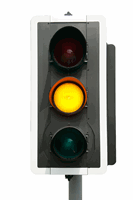
B
C
D
Correct Answer: C
Explanation: At junctions controlled by traffic lights, you must stop behind the white line until the lights change to green. A red light, an amber light, and red and amber lights showing together all mean stop. You may proceed when the light is green unless your exit road is blocked or pedestrians are crossing in front of you. If you're approaching traffic lights that are visible from a distance and the light has been green for some time, be ready to slow down and stop, because the lights are likely to change.
Explanation: At junctions controlled by traffic lights, you must stop behind the white line until the lights change to green. A red light, an amber light, and red and amber lights showing together all mean stop. You may proceed when the light is green unless your exit road is blocked or pedestrians are crossing in front of you. If you're approaching traffic lights that are visible from a distance and the light has been green for some time, be ready to slow down and stop, because the lights are likely to change.
37. You're on a motorway. A red cross is displayed above the hard shoulder. What does this mean? Mark one answer
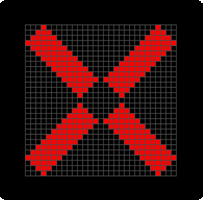
B
C
D
Correct Answer: D
Explanation: Active traffic management operates on some motorways. Within these areas, at certain times, the hard shoulder will be used as a running lane. A red cross above the hard shoulder shows that this lane should only be used for emergencies and breakdowns.
Explanation: Active traffic management operates on some motorways. Within these areas, at certain times, the hard shoulder will be used as a running lane. A red cross above the hard shoulder shows that this lane should only be used for emergencies and breakdowns.
A
B
C
D
B
C
D
Correct Answer: D
Explanation: Other drivers or riders may have to change course due to the size or characteristics of their vehicle. Understanding this will help you to anticipate their actions. Motorcyclists and cyclists will be checking the road ahead for uneven or slippery surfaces, especially in wet weather. They may need to move across their lane to avoid surface hazards such as potholes and drain covers.
Explanation: Other drivers or riders may have to change course due to the size or characteristics of their vehicle. Understanding this will help you to anticipate their actions. Motorcyclists and cyclists will be checking the road ahead for uneven or slippery surfaces, especially in wet weather. They may need to move across their lane to avoid surface hazards such as potholes and drain covers.
Correct Answer: C
Explanation: If you have to leave your vehicle and get out of a tunnel by an emergency exit, do so as quickly as you can. Follow the signs directing you to the nearest exit point. If there are several people using the exit, don't panic but try to leave in a calm and orderly manner.
Explanation: If you have to leave your vehicle and get out of a tunnel by an emergency exit, do so as quickly as you can. Follow the signs directing you to the nearest exit point. If there are several people using the exit, don't panic but try to leave in a calm and orderly manner.
40. You're involved in a collision. Afterwards, which document may the police ask you to produce? Mark one answer
AB
C
D
Correct Answer: A
Explanation: You must stop if you've been involved in a collision which results in injury or damage. The police may ask to see your driving licence and insurance details at the time or later at a police station.
Explanation: You must stop if you've been involved in a collision which results in injury or damage. The police may ask to see your driving licence and insurance details at the time or later at a police station.
Correct Answer: D
Explanation: Consult the vehicle handbook or a garage before driving the vehicle any further. Only drive to a garage if it's safe to do so. If you aren't sure, get expert help.
Explanation: Consult the vehicle handbook or a garage before driving the vehicle any further. Only drive to a garage if it's safe to do so. If you aren't sure, get expert help.
42. You're driving on a motorway and have to slow down quickly due to a hazard ahead. How can you warn drivers behind of the hazard? Mark one answer
AB
C
D
Correct Answer: C
Explanation: Using your hazard warning lights, as well as your brake lights, will give following traffic an extra warning of the problem ahead. Only use them for long enough for your warning to be seen.
Explanation: Using your hazard warning lights, as well as your brake lights, will give following traffic an extra warning of the problem ahead. Only use them for long enough for your warning to be seen.
43. You're driving a vehicle that has anti-lock brakes. How should you apply the footbrake when you need to stop in an emergency? Mark one answer
AB
C
D
Correct Answer: A
Explanation: You may have to stop in an emergency due to a misjudgement by another driver or a hazard arising suddenly, such as a child running out into the road. If your vehicle has anti-lock brakes, you should apply the brakes immediately and keep them firmly applied until you stop.
Explanation: You may have to stop in an emergency due to a misjudgement by another driver or a hazard arising suddenly, such as a child running out into the road. If your vehicle has anti-lock brakes, you should apply the brakes immediately and keep them firmly applied until you stop.
Correct Answer: A
Explanation: All vehicles need to be serviced to keep working efficiently. An efficient engine uses less fuel and produces fewer harmful emissions than an engine that's running inefficiently. Keeping the vehicle serviced to the manufacturer's schedule should also make it more reliable and reduce the chance of it breaking down.
Explanation: All vehicles need to be serviced to keep working efficiently. An efficient engine uses less fuel and produces fewer harmful emissions than an engine that's running inefficiently. Keeping the vehicle serviced to the manufacturer's schedule should also make it more reliable and reduce the chance of it breaking down.
Correct Answer: A
Explanation: Some bus lanes operate only during peak hours and other vehicles may use them outside these hours. Make sure you check the sign for the hours of operation before driving in a bus lane.
Explanation: Some bus lanes operate only during peak hours and other vehicles may use them outside these hours. Make sure you check the sign for the hours of operation before driving in a bus lane.
46. You're driving in busy traffic. You want to pull up on the left just after a junction on the left. When should you signal? Mark one answer
AB
C
D
Correct Answer: A
Explanation: You need to signal to let other drivers know your intentions. However, if you indicate too early, they may think you're turning left into the junction. Correct timing of the signal is very important to avoid misleading others.
Explanation: You need to signal to let other drivers know your intentions. However, if you indicate too early, they may think you're turning left into the junction. Correct timing of the signal is very important to avoid misleading others.
47. You're waiting to emerge from a junction. The windscreen pillar is restricting your view. What should you be particularly aware of? Mark one answer
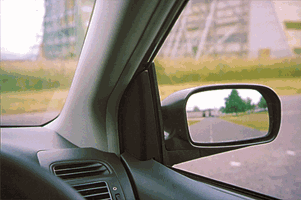
B
C
D
Correct Answer: D
Explanation: Windscreen pillars can completely block your view of pedestrians, motorcyclists and cyclists. You should make a particular effort to look for these road users; don't just rely on a quick glance.
Explanation: Windscreen pillars can completely block your view of pedestrians, motorcyclists and cyclists. You should make a particular effort to look for these road users; don't just rely on a quick glance.
48. In which conditions should you leave at least a two-second gap between your vehicle and the one in front? Mark one answer

B
C
D
Correct Answer: B
Explanation: In good, dry conditions, a driver needs to keep a distance of at least two seconds from the car in front. This should allow enough space for you to stop if the driver in front has to stop suddenly.
Explanation: In good, dry conditions, a driver needs to keep a distance of at least two seconds from the car in front. This should allow enough space for you to stop if the driver in front has to stop suddenly.
49. What will happen if you hold the clutch pedal down or roll in neutral for too long? Mark one answer
AB
C
D
Correct Answer: C
Explanation: Holding the clutch down or staying in neutral for too long will cause your vehicle to freewheel. This is known as 'coasting' and it's dangerous because it reduces your control of the vehicle.
Explanation: Holding the clutch down or staying in neutral for too long will cause your vehicle to freewheel. This is known as 'coasting' and it's dangerous because it reduces your control of the vehicle.
50. Your vehicle breaks down on the hard shoulder of a motorway. You need to use your mobile phone to call for help. What should you do? Mark one answer
AB
C
D
Correct Answer: A
Explanation: You should use an emergency telephone when you break down on the motorway; only use your mobile if this isn't possible. The emergency services need to know your exact location so they can reach you as quickly as possible. Look for a number on the nearest marker post beside the hard shoulder. Give this number when you call the emergency services.
Explanation: You should use an emergency telephone when you break down on the motorway; only use your mobile if this isn't possible. The emergency services need to know your exact location so they can reach you as quickly as possible. Look for a number on the nearest marker post beside the hard shoulder. Give this number when you call the emergency services.



